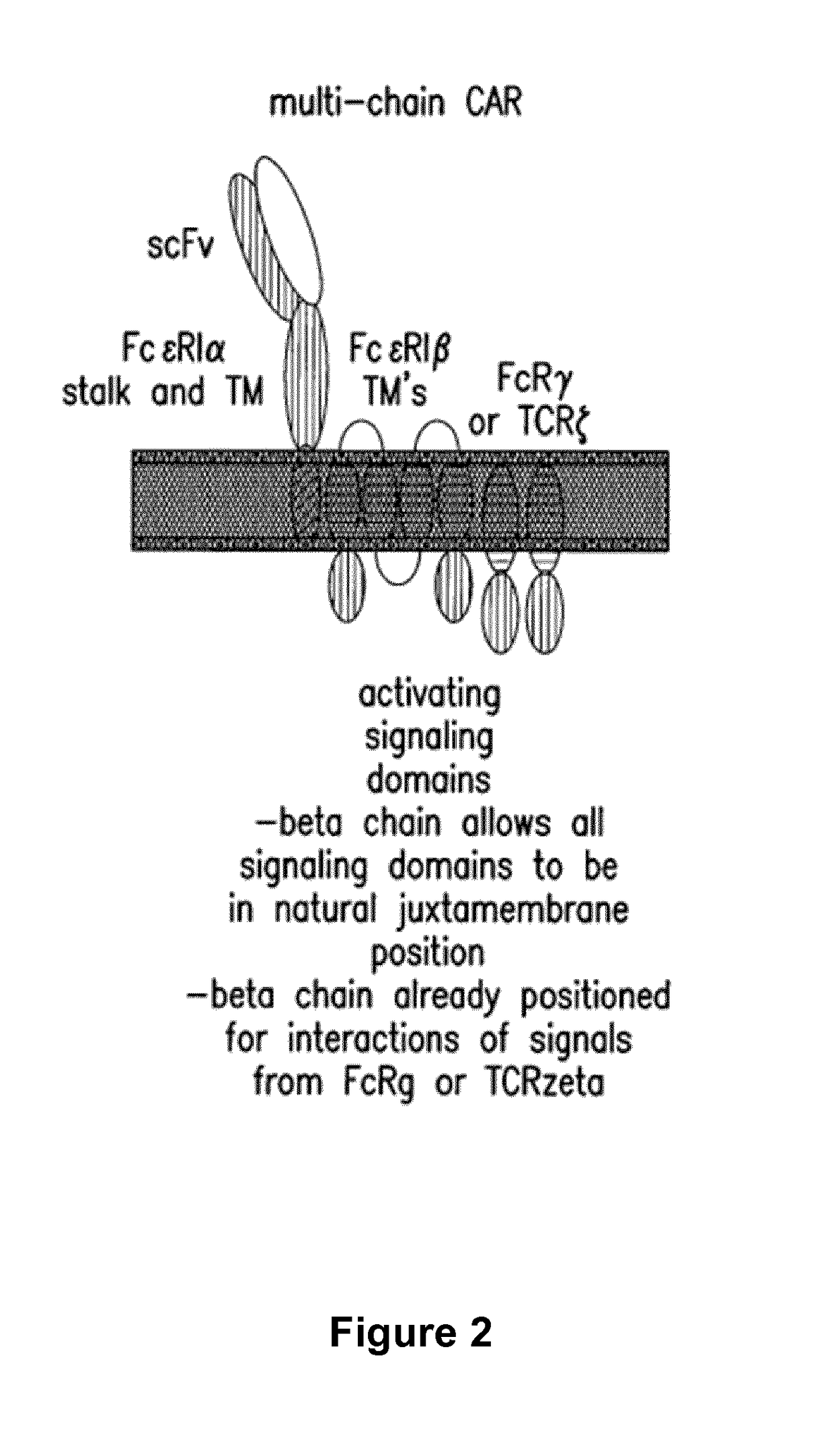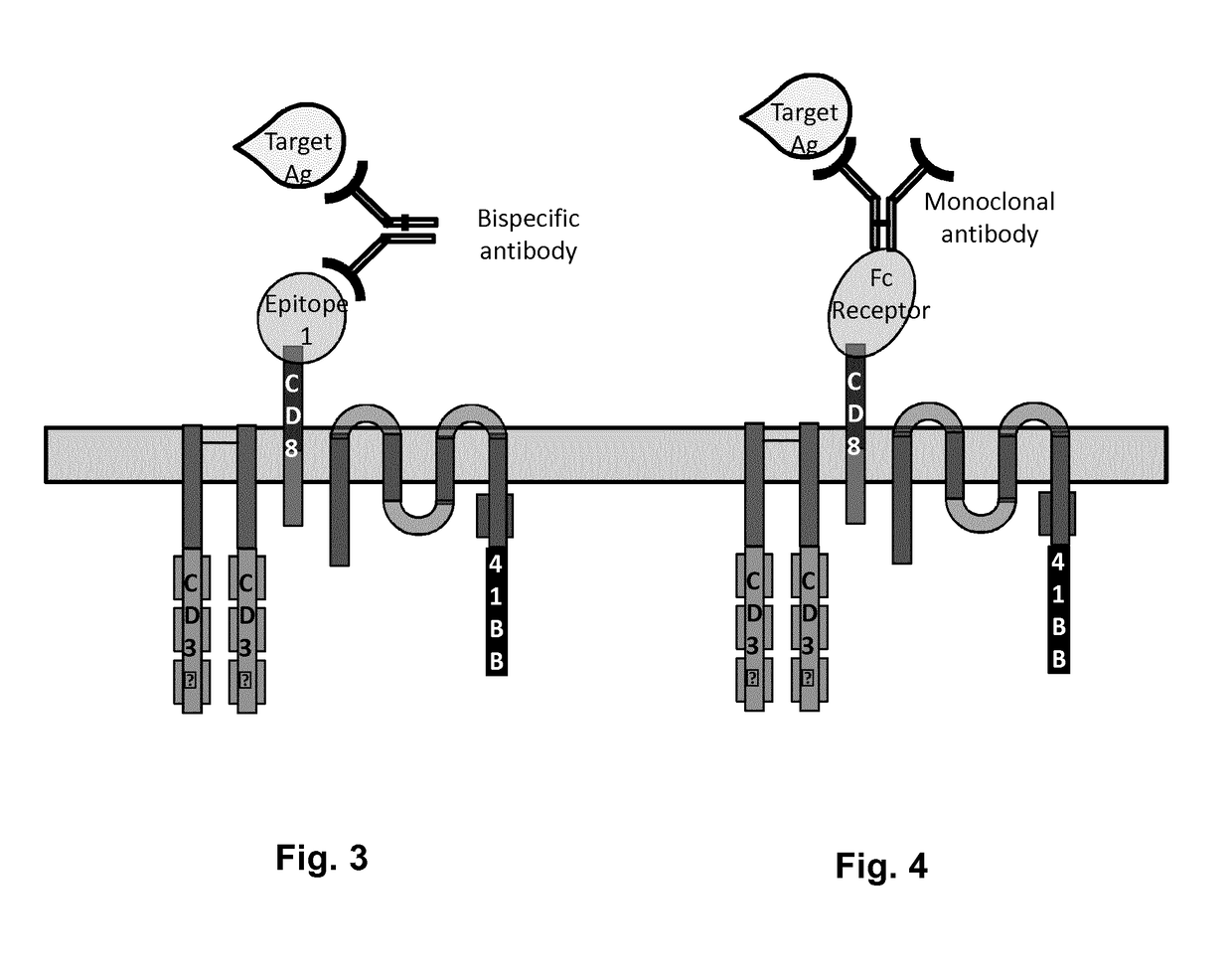Cells for immunotherapy engineered for targeting antigen present both on immune cells and pathological cells
a technology of immune cells and cells, applied in the direction of genetically modified cells, antibody medical ingredients, drug compositions, etc., can solve the problems of inability to provide prolonged expansion and anti-tumor activity in vivo, degraded immune function, and low number of patient's lymphocytes
- Summary
- Abstract
- Description
- Claims
- Application Information
AI Technical Summary
Benefits of technology
Problems solved by technology
Method used
Image
Examples
example 1
(Ko) on Cd38 Gene & Expression of Anti-Cd38 Car
[0229]Presentation of the CD38 Target—
[0230]cyclic ADP ribose hydrolase
[0231]CD38 is a glycoprotein found on the surface of many immune cells, including multiple myeloma (MM) cells that express a high level of CD38 in a large majority of patients. CD38 is a validated target for MM as many studies have shown efficient killing of CD38+MM cells from patients and CD38+MM cell lines using anti-CD38 mAbs by CDC and ADCC (Ellis, J. H. K. et al, Journal of Immunology, 1995, 155 (2), 925-937). Daratumumab is a therapeutic human CD38 monoclonal antibody which induces killing of multiple myeloma and other hematological tumors (De Weers, M. et al, J Immunol 2011 186:1840-1848). In some studies, it has been shown that CD38 is also highly expressed by activated T cells (Sandoval-Montes C J et a, 2005, Leukoc Biol. 77(4):513-21).
[0232]Expression of CD38 by T-cells
[0233]The CD38 expression by T cells after CD3 / CD28 beads and IL-2 stimulation was analyz...
example 2
Activity of Anti-CS1 Car in the Context of CS1 Ko
[0256]Presentation of CS1 Target
[0257]Multiple myeloma (MM) is a B-cell malignancy characterized by the aberrant clonal expansion of plasma cells (PCs) within the bone marrow, with an estimated 21,700 new cases and 10,710 deaths from MM identified in the United States in 2012 (Siegel R, et al. Cancer J Clin 2012 62:10-29). In 2013, it has been estimated that 22,350 individuals will be newly diagnosed with MM in the United States and 10,710 people will die from it, accounting for 20% of the deaths from all hematologic malignancies. Despite the use of proteasome inhibitors and immune-modulating drugs, which have improved overall survival (Palumbo A, et al. Leukemia 2009 23:449-456), MM remains an incurable malignancy (Podar K, et al. Leukemia 2009 23:10-24) for which novel therapeutic approaches are urgently needed.
[0258]The cell surface glycoprotein CS1 (also referred in the literature as SLAMF7, CD319 or CRACC-NCBI Reference Sequence:...
example 3
et
[0291]Presentation of CD70 Target
[0292]The CD70 is a cytokine that binds to CD27 and is part of the TNF family (Goodwin R. G. et al, 1993, Cell 73:447-456). This protein has a role in adaptive T cell responses, induces the proliferation of costimulated T-cells and enhances the generation of cytolytic T-cells. Its accession number is P32970 (Uniprot). Some studies such as in Schürch, C. et al. (J. Clin. Invest., 2012; doi:10.1172 / JC145977) suggest that blocking CD27-CD70 interactions could help treat chronic myelogenous leukemia (CML).
[0293]Strategy for CD70 KO
[0294]The same strategy for the KO of CD70 gene will be performed such as in Example 1 and Example 2. Heterodimeric TALE-nuclease targeting two 49-pb long sequences separated by a 15 pb spacer within the CD70 gene and one TALE-nuclease targeting a 57-pb long sequence separated by a 23 pb spacer were designed and produced. Each half target is recognized by repeats of the half TALE-nucleases listed in the following Table 22.
TAB...
PUM
| Property | Measurement | Unit |
|---|---|---|
| voltage | aaaaa | aaaaa |
| voltage | aaaaa | aaaaa |
| voltage | aaaaa | aaaaa |
Abstract
Description
Claims
Application Information
 Login to View More
Login to View More - R&D
- Intellectual Property
- Life Sciences
- Materials
- Tech Scout
- Unparalleled Data Quality
- Higher Quality Content
- 60% Fewer Hallucinations
Browse by: Latest US Patents, China's latest patents, Technical Efficacy Thesaurus, Application Domain, Technology Topic, Popular Technical Reports.
© 2025 PatSnap. All rights reserved.Legal|Privacy policy|Modern Slavery Act Transparency Statement|Sitemap|About US| Contact US: help@patsnap.com



